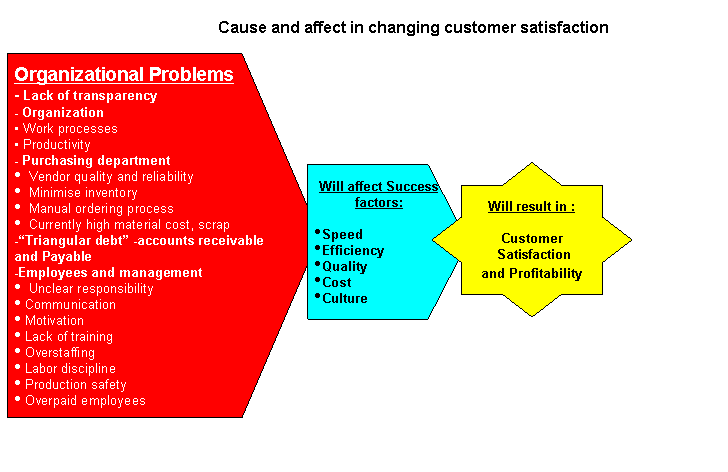Alternative company Model
The CEO of the Jiangshan has identified the respective problems and wanted to look specific into the purchasing department. In creating consistency in Jiangshan, major organizational changes (overhaul of the whole company structure) are needed instead of making the purchasing department a single entity. The Chinese business culture differs from that of the western ones and it should therefore be taken into consideration when making the appropriate organizational alterations. An example of how Total Quality Measurements (TQM) is incorporated into a Chinese context is the case of Haier group because the environment as described earlier is characterized by increased competition on price, cost and quality. Furthermore, there will be incorporated some western thinking by using Management Performance Measurements (MPM) as a measure of management’s performance to support the TQM.
Problems, cause and effect
By pinpointing the operational problems within Jiangshan one will be able to address these issues and perform the appropriate changes in improving Speed, efficiency, Quality, cost and overall company culture. In other words, customer’s non-stop search for cheaper and better products would force the supplier to continuously improve their TQM. Continuously improving TQM will result in higher customer satisfaction and hence foster profits over medium to long term.
Re - Develop the existing organizational structure
Due to the nature of the business (manufacturing) and unique Chinese cultural context, a hierarchical structure organized around the products produced is proposed. The new organizational chart will clarify the responsibility centres, mapping revenue costs drivers of the operations. Furthermore, it is proposed to introduce a touch of western managerial thinking in this organizational circumstance. The most immediate problem in Jiangshan is the inefficient organization with lack of transparency. This structure makes it difficult to measure cost allocation and implementation of incentive systems.
Proposed structure:
The new hieratical structure will have head quarter which leads five divisions:
- Support functions
- Purchasing
- Specialized /tailor-made products
- Standardized products
All the divisions will have a VP who will be the part of executive team.
The following sections identify how the proposed new organization affect the above mentioned success factors
Organizational setup

Headquarters- executive team
The executives will be responsible in incorporating the future strategy and operations. Chenhall (1997) argues that MPM is essential to both operational and strategic control as it provide feedback and information from managers.
“Strategies of TQM, when combined with a reliance on MPM are likely to lead to enhanced profitability because of feedback from operations that: (1) increase the clarity of factors associated with developing complementarities between elements of TQM; (2) focus managers attention on these factors; and (3) strengthen motivation to pursue these aspects of manufacturing. Thus, it is proposed that organizational profitability is likely to be higher in situations with TQM with a high reliance on MPM, than in situations with low reliance on MPM” Chenhall (190:1997). Ergo incorporating TQM with heavy reliance on MPM is vital in growing organizational profits and creates transparency. It should be integrated it into the culture of Jiangshan in an early stage.

Product divisions:
The each production divisions (Specialized and General Products) will have their sales department as supporting function to generate sales. In this type of an organization, the manufacturing will be organized as a production line. However it is important to distinguish between the standardized and the specialized production units to give focus. Common for both the units is that quality, cost, speed and efficiency should be enhanced. In the standardized production, it is economy of scale that is most important and standardizing work processes would be essential. The Chinese cultural behaviour (i.e. Guanxi) allows for opportunistic behaviour. Ergo, it is vital that one evaluates performance and output on an individual level so transparency becomes apparent. One should include penalties and incentive schemes to enhance production and quality output of every employee.
In the specialized manufacturing unit, continuous innovation is important in making more innovative products. As strong control measurements may be a set back to innovation, it is proposed to evaluate performance on the supervisors’ level to create more flexibility. The supervisor will control costs and efficiency of his team which should be less than 10 people so it does not become too opaque. One should motivate work-circulation and incorporate a horizontal measurement basis for the reward system.
Cost centres should be allocated to the supervisors’ part of the production line and make its way through production line managers, to production manager and end at CEO. The revenue centres are identified by sales of the relevant department. VP for the respective manufacturing unit will ensure revenue and costs (production and purchasing) are matching. Control and measurements, will be the responsibility of the VP product manager in ensuring revenue versus costs.
Purchasing division:
The purchasing department should not be outsourced since it is a vital part of the business. It will be organized into cost centres, reflecting the production organization. The product divisions should also take control of the purchasing with particular emphasis of sourcing (procurement) of materials, quality and efficiency. Weekly or at worst monthly KPIs to measure performance and procurement with respect to time and suppliers are essential at the supervisory level.
Again, installing a new IT system will improve the current manual ordering processes and allocate costs automatically to products, as purchasing ordering take place. Forecasting should be carried out in planning future demand from the production departments. This would enable the purchasing department to lower its inventory (hence potential scrap) and enable closer relationship from its suppliers (who can plan production and delivery more accurate). The purchasing department should also get more autonomy in decision making and should be looked upon as an integrated part of the value chain interacting with the production departments. Material cost will be reported to the product VP’s, who is responsible for each profit centre (described in above section). The VP in purchasing department is measured and rewarded based on the performance of the department.
Support division:
Cost of these supporting functions is defined as overhead cost and will be allocated to the profit centre in the product departments using the Activity Based Cost (ABC) principles.
The quality assurance department
The quality department should be given full autonomy to perform expected and unexpected quality checks in work floor to ensure that quality is sufficient. They should also be educated in checking the quality of purchasing department to ensure that no opportunistic behaviour occurs in the purchasing process. They should work on an incentive based system where they get bonuses in finding defects.
Measurement and reward system:
In the new organization there should be possible to measure cost centres’ performance of the production team and these measurements should be used for reward systems. Measurement systems will measure vertical on product cost and horizontal on efficiency and quality.
There are four measurement systems that are suggested for the restructured Jiangshan:
- TQM - Total Quality Management which will measure cost and efficiency in the production line.
- MPM – Manufacturing performance measures system which will measure individual performance in the value chain. This system will give feedback on quality of the product before it leaves the shop floor.
- Accounting measurement system- it will reflect responsibility centres in the organizational structure. That will give the possibility to allocate costs to the relevant cost centres; revenue centres, profit and even Investment centres, and that will give a high level of accounting control.

Each step in the value chain / function will have allocated cost centres and all the cost centers will be measured in the hierarchical organizational structure. In addition the vertical measurement systems will be implemented within functions. These measures will be the foundation for calculation of the incentive schemes. By implementing incentive systems which are linked to performance, it is expected that responsibility and accountability will increase.
Conclusion:
Studies have shown that by incorporating TQM with a heavy reliance on MPM will grow organizational profits and create more transparency. Jiangshan will create clear responsibility, proper measurement system and reward system. Additionally, it will increase responsibility and accountability among the employees. However, because the company culture and the management of this SOE are not educated in how to incorporate TQM and MPM, the company is expected to face major problem in restructuring process. The changes will create uncertainty and rivalry, and most certainly disturb the harmony of organizational behaviour in the company. Therefore, it is important to educate the people and continuously involve all the employees in the restructuring process.
The restructuring process will be difficult for CEO- Mr. Wang since this will most certainly ensure redundancies albeit keeping in mind that resistance to changing the company would mean bankruptcy for the company. Redundant personnel especially in the purchasing department should not be laid off but replaced into other vacancies within the company if possible.
Restructuring the only purchasing department will have limited effect on the company performance. In maintaining its premium status as a manufacturing company the whole firm needs to restructured. A hierarchical structure is proposed to create transparency and accountability. Measurable work processes will make it possible to implement reward/incentive systems, this will increase motivation, efficiency and quality.
